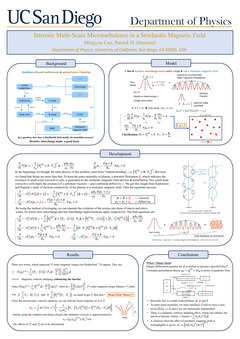Intrinsic Multi-Scale Microturbulence in a Stochastic Magnetic Field
ID:3
View Protection:PUBLIC
Updated Time:2021-06-16 21:09:01
Hits:1216
Poster Presentation

Start Time:2021-07-12 10:40 (Asia/Shanghai)
Duration:20min
Session:[E] E-poster » [E] E-poster
Abstract
Edge-localized modes (ELMs), a consequence of H-mode, may result in devastating damage to the first wall through instantaneous bursts of heat and particles. In experiments, resonant magnetic perturbation (RMP) serves as a viable way to control ELMs. It is a well-accepted consensus that the suppression of turbulence when heating power exceeds a threshold value leads to L-H transition. To determine how stochastic magnetic fields generated by RMP affect the L-H transition, it is essential to study their influence on linear instabilities, since such instabilities are the origin and drives of plasma turbulence. The tractability of resistive interchange mode makes it a good focus for the initial study. This work aims to investigate how a high-\(k\) stochastic magnetic field background modifies the dynamics of a low-\(k\) resistive interchange mode. This is relevant to the question of L-H transition with RMP.
Unlike previous work, such as the test particle picture [1], the quasi-neutrality of plasma (i.e., \(\nabla\cdot J=0\) ) is enforced at all orders in this work. Starting with the vorticity equation in a stochastic magnetic field, we find that to maintain quasi-neutrality a high-\(k\) potential fluctuation \(\tilde{\phi}\) is generated by the stochastic field and the low \(k\) perturbations. Physically the appearance of \(\tilde{\phi}\) means the existence of small-scale convection cells. These further imply the existence of a small-scale transport - specifically, a turbulent viscosity \(\nu\) and a turbulent diffusivity \(\chi\) . We use the method of averaging to separate the evolution of the system into coupled equations for macro and micro scales, for which the slow-interchange and fast-interchange approximations apply, respectively. Applying mean-field theory to the vorticity equation at the micro scale, the response of \(\tilde{\phi}\) to \(\tilde{\mathbf b}\) is obtained. In the end, the stochastic differential equation is transformed into a macroscopic integro-differential equation, in which a third-order magnetic torque appears along with other contributions. This result is reminiscent of that from Rutherford’s nonlinear island calculation [2]. The key physics is the same, modulo multi-scale effects. We conclude that part of the effect of stochastic magnetic field is to drive increased effective inertia of the plasma and thus stabilize the system. Other effects remain to be clarified and may be destabilizing. No electron viscosity effects appear in this model. By regarding the interactions as small perturbations, the corrected growth rate of the envelope of electrostatic potential \(\bar{\phi}\) and the turbulent viscosity \(\nu\) are calculated, approximately. The implications for the physics of turbulent transport in a stochastic field will be disclosed.
Unlike previous work, such as the test particle picture [1], the quasi-neutrality of plasma (i.e., \(\nabla\cdot J=0\) ) is enforced at all orders in this work. Starting with the vorticity equation in a stochastic magnetic field, we find that to maintain quasi-neutrality a high-\(k\) potential fluctuation \(\tilde{\phi}\) is generated by the stochastic field and the low \(k\) perturbations. Physically the appearance of \(\tilde{\phi}\) means the existence of small-scale convection cells. These further imply the existence of a small-scale transport - specifically, a turbulent viscosity \(\nu\) and a turbulent diffusivity \(\chi\) . We use the method of averaging to separate the evolution of the system into coupled equations for macro and micro scales, for which the slow-interchange and fast-interchange approximations apply, respectively. Applying mean-field theory to the vorticity equation at the micro scale, the response of \(\tilde{\phi}\) to \(\tilde{\mathbf b}\) is obtained. In the end, the stochastic differential equation is transformed into a macroscopic integro-differential equation, in which a third-order magnetic torque appears along with other contributions. This result is reminiscent of that from Rutherford’s nonlinear island calculation [2]. The key physics is the same, modulo multi-scale effects. We conclude that part of the effect of stochastic magnetic field is to drive increased effective inertia of the plasma and thus stabilize the system. Other effects remain to be clarified and may be destabilizing. No electron viscosity effects appear in this model. By regarding the interactions as small perturbations, the corrected growth rate of the envelope of electrostatic potential \(\bar{\phi}\) and the turbulent viscosity \(\nu\) are calculated, approximately. The implications for the physics of turbulent transport in a stochastic field will be disclosed.
Keywords
resistive interchange;stochastic magnetic field;quasi-neutrality;turbulent transport;multi scale
Speaker

Comment submit